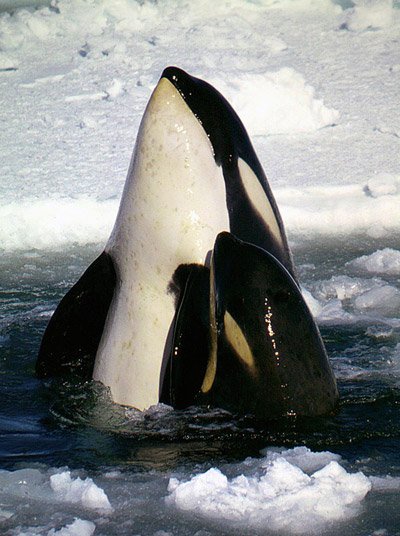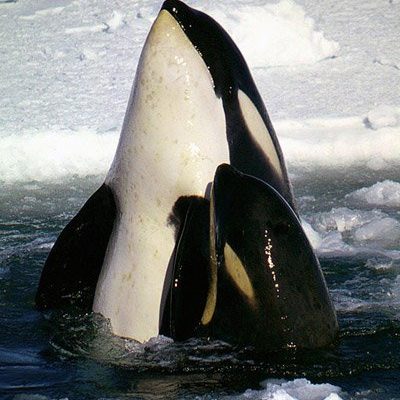
So, what exactly makes orcas such effective hunters and social creatures in the vast ocean? It’s all in their unique adaptations. From their specialized body structures to incredible communication methods, orcas are a prime example of nature’s ingenuity. Let’s dive deeper into the fascinating adaptations that allow these apex predators to rule the underwater world.
Streamlined Body Shape
Orcas have a uniquely shaped body that plays a crucial role in their ability to navigate through water. Their sleek, torpedo-like form reduces drag, allowing them to swim swiftly and efficiently. Picture a well-designed boat slicing through waves—that’s similar to how an orca moves.
With a streamlined body, orcas can reach speeds of up to 34 miles per hour (55 kilometers per hour). This is essential for chasing down fast prey like fish and seals. Their dorsal fin, which can be up to 6 feet tall in males, also helps maintain balance as they swim. The fin acts like a stabilizing sail, keeping them steady as they glide through their marine environment.
Another interesting feature is their powerful tail flukes. These large, paddle-like structures can propel orcas with great force. When it comes to hunting, this strength allows them to perform impressive leaps and bursts of speed to catch unsuspecting prey.
Advanced Echolocation
One of the most fascinating adaptations of the orca is its use of echolocation. Think of it like a natural sonar system. Orcas emit clicks and listen for the echoes that bounce back from objects in their surroundings. This ability helps them “see” their environment, even in murky waters where visibility is limited.
Here’s how it works: when an orca clicks, the sound waves travel through the water. If these waves hit an object, like a fish, they reflect back to the orca’s specialized ear structure. By analyzing the time it takes for the echo to return, orcas can determine the distance, shape, and even the size of the object. This adaptation is vital for hunting since it allows them to locate prey with precision.
Echolocation isn’t just used for finding food. Orcas also use it to communicate with other members of their pods. By adjusting the frequency of their clicks, they can convey different messages to one another, helping them stay connected even in deep waters.
Social Structure and Communication
Orcas are highly social animals, living in family groups known as pods. These pods can consist of a few individuals to more than 40 members, all working together to hunt and care for their young. Their social structure is remarkable, featuring strong family bonds that can last a lifetime.
Communication plays a key role in pod life. Orcas use a variety of vocalizations, including whistles, clicks, and pulsed calls. Each pod has its own unique dialect; it’s like they speak a specific language that only they understand. This helps them coordinate hunts, share information about food, and even socialize.
Strong social bonds enhance their hunting strategy, too. When hunting large prey, such as seals or whales, orcas often work together, using complex tactics to surround and catch their dinner. This teamwork not only boosts their chances of success but also strengthens relationships within the pod.
Blubber: The Ultimate Insulator
Living in cold ocean waters requires some serious adaptations to keep warm. Orcas have a thick layer of blubber beneath their skin, acting as an insulator against the chilly temperatures. This blubber can be up to 12 inches thick, providing not just warmth but also buoyancy, helping the orcas stay afloat with less effort.
Blubber isn’t just a bonus; it’s essential for their survival. In frigid waters, losing body heat can be fatal, so this adaptation is a lifesaver—literally. Interestingly, the thickness of their blubber can vary depending on the season and the orca’s location. During colder months, they can build up more blubber to endure the harsh conditions.
Moreover, blubber serves as an energy reserve. If food is scarce, orcas can rely on these fat stores to sustain themselves until they can hunt again. It’s nature’s built-in energy bar!
Coloration and Camouflage
Orcas have a striking black-and-white coloration that does more than just make them look cool. This unique pattern provides excellent camouflage in their underwater environment. When viewed from above, their dark backs blend in with the ocean depths, making it harder for prey to spot them. From below, their white bellies match the lighter surface of the water, making them nearly invisible to predators or prey swimming beneath them.
This method of camouflage is often referred to as “countershading.” It’s a clever way that many marine animals, like sharks and dolphins, disguise themselves. For orcas, this means they can sneak up on their prey without being detected, enhancing their hunting success.
The striking coloration also plays a role in social interactions. Individual orcas can be recognized by the distinct patterns and marks on their bodies, helping pods identify and bond with each other.
Intelligence and Problem Solving
Lastly, one of the standout features of orcas is their intelligence. These creatures are often seen solving complex problems and even using tools in the wild. For instance, some orcas have been observed using marine sponges to protect their snouts while hunting along the ocean floor. This innovative behavior showcases their ability to adapt and use resources in their environment—a hallmark of intelligence.
Orcas also demonstrate cultural behavior, learning from one another and passing down hunting techniques. This not only highlights their smarts but also their social nature. Imagine learning a family recipe passed down through generations—this is similar to how orcas share knowledge within their pods.
Their intelligence allows them to adapt to changing environments and challenges, ensuring their survival in an ever-evolving ocean.
Orcas are truly remarkable creatures, showcasing a variety of adaptations that allow them to thrive underwater. From their streamlined bodies and advanced echolocation to their strong social structures and intelligence, these adaptations are a testament to nature’s ingenuity. While they might look fierce and powerful, their success in the ocean is deeply rooted in their unique abilities and the bonds they share with one another.
Next time you think about killer whales, remember that their adaptations are not just fascinating—they are essential for their survival in the vast, unpredictable ocean. It’s a wild world down there, but orcas are definitely equipped to rule it!

